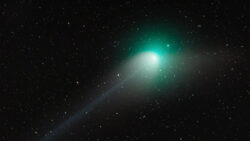Newly discovered green comet comes close to Earth
On Wednesday, a newly discovered comet will make its closest approach to our planet.
Astronomers say the object’s journey towards Earth took around 50,000 years.
Photographs show the comet with a distinct green hue around its body, but if you’re looking for it in the night sky you won’t see the green – its brightness is right at the threshold of what is visible to the naked eye.
“You might have seen these reports saying we’re going to get this bright green object lighting up the sky,” says Dr Robert Massey, deputy executive director of the Royal Astronomical Society.
“Sadly, that’s not going to be anything like the case.”
You will have a better chance of spotting it using binoculars, and live away from light pollution and below dark skies – it will look like a faint white blur.
Finding the comet
Comets are mostly ice and dust. As they approach the Sun, the ice is vaporised and the dust is shaken off to create the signature long tail.
The object originates in the Oort cloud, a collection of icy bodies at the edge of the Solar System.
Dr Massey, says to find the comet, first find the pole star, which is always in the same place in the sky.
You can find the pole star by looking directly north and locating a star that hangs distinctly by itself.
You can use free planetarium online software to determine where the comet will be moving in relation to the pole star on the night you’re looking at it.
The best time to view it will be the early hours of Thursday morning when the Moon has set.
The comet should appear just to the right of the pole star.





